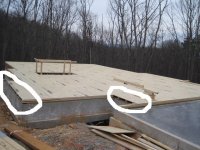Obed,
I want to say that my comments are meant to point out things that I notice in your pictures that you may not have noticed yourself. I don稚 have much confidence in your framer, and won稚 hide the fact that from early on, he痴 set off allot of red flags for me. I will also qualify my comments by saying that you are building a house unlike anything that I致e ever done before. Some things are basic and other things I just don稚 know. When somebody excuses something that they have done wrong by saying its how everybody else does it, I get nervous. When they brag on a great concrete job, but it痴 obviously not such a great job, I get nervous. When you have to start measuring your walls to see how far they are out of alignment, then have to shim up your trusses, I get nervous. With that said, I don稚 know if he痴 done anything that will affect the integrity of the building or not. Nothing jumps out to me as being incompetent or unsafe. It does bother me that he has had so many problems and it痴 just the beginning of the build. One or two things during the entire build might be normal, but he痴 setting records with so many little things that I壇 seriously consider pulling the inspector aside and asking him to do a more intensive look at the framing before passing it.
The headers might be code, but they look like an afterthought. I致e never seen anything quite like them.
Did he bolt the sill plates down to the concrete every six feet? Is that the load bearing wall in one of the pictures without any bolts in it? Or am I not looking at the right wall? Or am I just not seeing the bolts in the picture?
Have you measured the tread height of the stairs? I壇 have to look up the code to see what is allowed, but seven inches is what I always make mine. There is some variation that痴 allowed. It might just be the picture, but it looks like a pretty big step.
The decking looks nice, but I知 wondering why he didn稚 block the ends of the trusses before putting down the decking? It would have been very easy to do it without the decking in the way. Now it痴 going to take twice as long. Make sure he does this. You want to have solid support under your load bearing walls. This is important.
Again, I apologize for being negative. It seems that I知 always criticizing, and bringing up problems. I知 not trying to be rude and put down your builder at every opportunity. I see things that I don稚 understand, or think should be done differently, and want to make sure you see them too. It痴 your house and a HUGE investment. If you are happy with it, then that痴 all that matters. My comments are meant to help you out and offer suggestions that might allow you to build the best house possible.
Eddie

